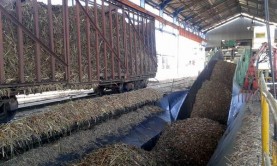When energy doesn’t run out
Cuba has set itself the goal of reducing the consumption of oil and other fuels through millions of dollars’ worth of investments to develop the renewable energy sources with foreign participation.

Los aerogeneradores instalados en Gibara, oriente cubano, han transformado la imagen, los conceptos y las expectativas energéticas de un país que todavía depende rígidamente del petróleo.
Foto: Tomada de periódico Vanguardia
International experts confirmed in the last week of May Cuba’s growing interest in technologies and renewable energy sources. It has more than enough historical reasons. The high dependence on oil has weighed too much on the economy, the environment and society; it has been behind each good moment and, with crudeness, behind each one of the economic crises Cubans have lived since the last century.
During the 8th International Conference on Renewable Energy, Energy Saving and Energy Efficiency (CIER 2015), held in Havana May 26-28, participants from 17 countries analysed the alternatives promoted on Cuban territory for the expansion of wind, solar and hydraulic power, among others. Compared to the most common technology events in Cuba for decades, among the more than 300 delegates present there were also representatives of foreign companies.
“We have shown the international community what Cuba is doing in relation to wind and solar power, its principal results and the perspectives up to 2030, especially envisaging the possibilities for foreign investment for setting it up,” said the director of the Centre for the Study of Renewable Energy Technologies (CETER), Tania Carbonell Morales, president of the event’s organising committee.
There are projects for tender and the search for agreements with foreign companies specialising in the development of this type of technology, Carbonell announced in statements published by Granma, one of the newspapers with the biggest circulation in the country.
This Caribbean nation aims to install 13 wind power parks with a total capacity of 633,000 kW. It already has four of them. One of the regions with the best wind conditions is located along the north coast of eastern Cuba. This is confirmed by the two most modern parks, of 12 wind-driven generators each one, with Spanish and Chinese technology. Last year they contributed as a whole more than 15,000 megawatt/hours to the National Electricity System, according to preliminary reports.
As a prior antecedent, in Cuban rural areas the use of windmills is customary to pump water. At present more than 8,000 of them have been installed, according to the Cuban Society for the Promotion of Renewable Energy Sources and Respect for the Environment (CUBASOLAR).
During the 8th Conference, guests and exhibitors from Ecuador, Colombia, Brazil, Mexico, Panama and Canada shared the halls of the Convention Centre with representatives from Spain, Germany, France and Israel, the latter with information about the use of hydrogen as fuel, pointed out Carbonell.
In an effort to transform the country’s energy matrix, Cubans have also set their sights on another relevant aspect of the Caribbean climate: the sun. According to CUBASOLAR estimates, the largest of the Caribbean islands registers an average solar radiation of around 1,800 kW/h per square metre per year. To use it, this year solar parks have to be built in several provinces in order to raise the installed capacity to a total of 45 MW. It already has eight of them located throughout the archipelago. The one with the largest capacity, Santa Teresa-Los Güiros, is located in the easternmost province of Guantánamo, identified for its high temperatures and the semi desert climate of some regions.
The aim is to increase by 2025 solar power generation to 700 MW, said doctor in sciences Daniel Stolik Novygrod, professor of the Faculty of Physics and the Institute of Radioactive Materials of the University of Havana, who participated in CIER 2015.
Economy Minister Marino Murillo reported to the MPs in 2014 that the government plans to invest 3.6 billion dollars in the next 15 years to develop alternative energies; they are included among the areas prioritised for foreign investment.

In addition to the installations for the use of wind and solar power, another source with great potential is biomass, especially sugar cane residues and the sugar industry. The government has short- and mid-term plans to build 19 bioelectric plants connected to sugar factories. The three most advanced are located in areas neighbouring the Jesús Rabí (Matanzas province), Ciro Redondo (Ciego de Avila) and 5 de septiembre (Cienfuegos) sugar factories.
Bioelectricity must solidly expand its leading position in the chapter of the renewable energy sources.
Cuba expects to transform the energy matrix in 15 years. From 4.3 per cent of the current participation, the renewable energy sources would increase to up to 24 per cent in 2030: biomass (14 per cent), wind (6 per cent), solar (3 per cent) and hydraulic (1 per cent). The contribution of oil and its derivatives would decrease from 77.2 per cent today to 54 per cent; the rest would be guaranteed by other fossil fuels.
Tania Carbonell and other participants of the Cuban side in CIER 2015 insistently defended the renewable alternative to achieve a sustainable development. Judging by the government plans, it stopped being a scientists’ dream. (2015)
Su dirección email no será publicada. Los campos marcados * son obligatorios.
Normas para comentar:
- Los comentarios deben estar relacionados con el tema propuesto en el artículo.
- Los comentarios deben basarse en el respeto a los criterios.
- No se admitirán ofensas, frases vulgares ni palabras obscenas.
- Nos reservamos el derecho de no publicar los comentarios que incumplan con las normas de este sitio.
